Farming the Fringe
Four Families Push the Boundaries of Agriculture on the Santa Barbara Coast
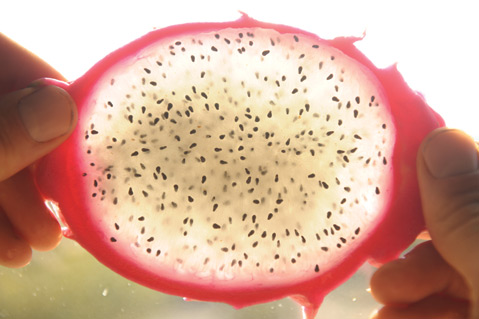
Though bigger-city restaurants and chefs tend to get credit for sparking a broader movement, the farm-to-table aesthetic is deeply entrenched in the bloodline of everyday Santa Barbarans, who’ve been rejoicing in weekly Farmers Markets since the early 1980s and living off the region’s thankfully reliable bounty for even longer.
Our commitment to that lifestyle — which, we know, isn’t always the thriftiest option — enables generations of farmers and ranchers to survive and thrive while also serving as the perfect environment for agricultural experimentation. If Santa Barbarans can’t support a particular crop, then probably no one will.
So this week we are celebrating a few farms that are pushing the boundaries of what can be harvested here along the Santa Barbara coastline, from pigs to papayas, coffee to cherimoyas, good money to sustainable mindfulness.
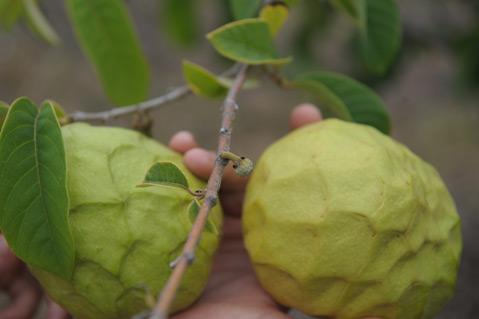
CaliTropics • Rincon del Mar • S.B. Exotics • Gigi’s Rancho el Rincon: Championing the Cherimoya
Who: The extended Brown family.
What: Cherimoyas, plus avocados, calla lilies, apples, and pineapple guavas.
Where: More than 100 acres and two packing houses in the foothills of Carpinteria.
When: Though the Browns have been citrus growers for a century, the cherimoya trees were planted in the 1970s.
How: There’s no denying the exoticness of a good and proper cherimoya. Oblong and green, the fruit has a sneaky density to it and a skin that is flecked with ridges and knobs oddly reminiscent of what it might feel like to pet a dinosaur. But the real wonders come once you crack one open; the inside is a truly delicious, albeit seed-riddled, soft, and sweet fruit with a sherbet-like consistency that was a fabled delicacy of the Incas.
“Most people have never seen a cherimoya before, and it can be a pretty hard thing to describe, so I like to show it to them and let them try some,” explained Sierra Brown, whose family has been the primary cherimoya growers and packers in North America since the 1970s. “As soon as they have a taste, the response is always, ‘That’s amazing!’ or ‘Wow, that’s interesting.’ I mean, for people who love cherimoyas, they really love them.”
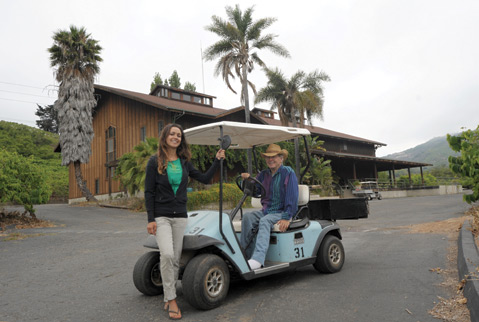
At one time, after Sierra’s great-grandfather immigrated from France and worked his way west to settle on the South Coast just over 100 years ago, the Brown family owned much of the coastline from Santa Barbara to Carpinteria. Citrus was the name of the game then and stayed that way until the 1970s, when the infamous cinnamon root rot decimated the region’s crops. The Browns, then presided over by Sierra’s widowed grandmother Mary Rose, were wiped out.
That’s when Sierra’s dad, Steven, along with his brothers Tony, Johnny, and Peter Nichols, made the fateful pivot to cherimoyas. It was Sierra’s uncle Tony, the “botanist of the family,” who searched out the fruit and then hybridized the two most commonly grown varieties of the cherimoya, the “Rincon” and the “Lisa,” and the family’s remaining holdings in the foothills of Carpinteria behind Rincon and on Casitas Pass Road became ground zero for the fickle fruit’s North American invasion.
Though experts like to debate whether the cherimoya is native to the Andes or regions of Central America, where very similar fruits grow in the wild, there is no doubting that this exotic, whose season runs November to June, does not belong in these parts. In fact, since there are no native pollinators here, each tree must be hand-pollinated by paintbrush — no small task when you’re talking about thousands and thousands of trees. CaliTropics, the company owned by Sierra’s immediate family, tends to 27 acres with about 100 trees per acre. She admitted, “It can get pretty intense.”
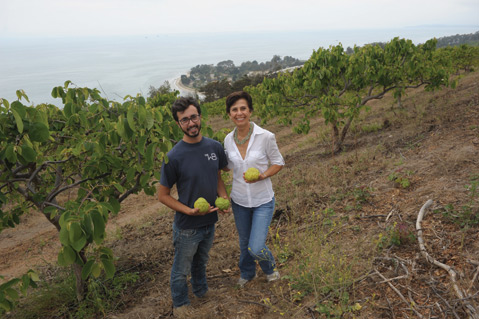
Today, the extended Brown family is involved in most, if not all, of the commercial cherimoya growing in California, be it through their packing house operations or actual farming. The family ranches started splitting up a bit in the 1990s, but all of Mary Rose’s children are still in the cherimoya game: Johnny and Steven run the CaliTropics ranch and packing house; Peter Nichols has S.B. Exotics in Carpinteria; and Tony runs Rincon del Mar just off Highway 150 with his son, Nick, who also runs his mother’s adjacent property, Gigi’s Rancho El Rincon, together selling fruit all the way down to Santa Monica and Mar Vista.
“It is a direct but friendly competition that we have with each other, and we all are really respectful of each other’s clientele,” summed up Sierra with a smile. “It’s not an easy fruit to grow or eat, but my grandmother was a matriarch, and I like to think we are all helping keep it alive for her.”
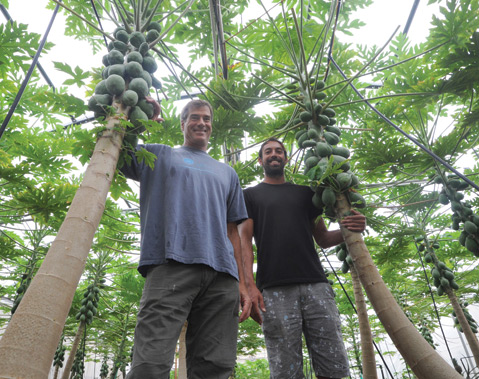
Golden State Papayas: Tackling the Tropicals
Who: Damien Raquinio and Adam Rhodes.
What: Papayas, plus pineapples and bananas.
Where: Three large-scale greenhouses (soon to be four) off Nidever Road in Carpinteria.
When: The first trees were planted in 2011.
How: In a series of nondescript warehouses just east of the Santa Barbara Polo fields, Damien Raquinio and Adam Rhodes are trying to do the near impossible: grow finger-licking-good, sweet, Hawaiian-style strawberry papayas on the California coast. Walking past his rows of several hundred trees on a recent foggy morning, Raquinio was more serious than joking when he said, “You look at these guys wrong or talk to them wrong, and they just crash and burn. We’ve basically been failing and trying and failing and trying for three years now.”
But success seems imminent because whenever Rhodes and Raquinio peddle their papayas at the farmers markets, they’re the darlings of the scene, regularly selling out and coveted by such restaurants as The Hungry Cat, Sama Sama, and the Wine Cask’s Intermezzo for dessert and drink recipes. After all, papayas are celebrated the world over for their low-fat, low-calorie, high-fiber, high-vitamin-C, digestion-helping, and cancer-fighting ways.
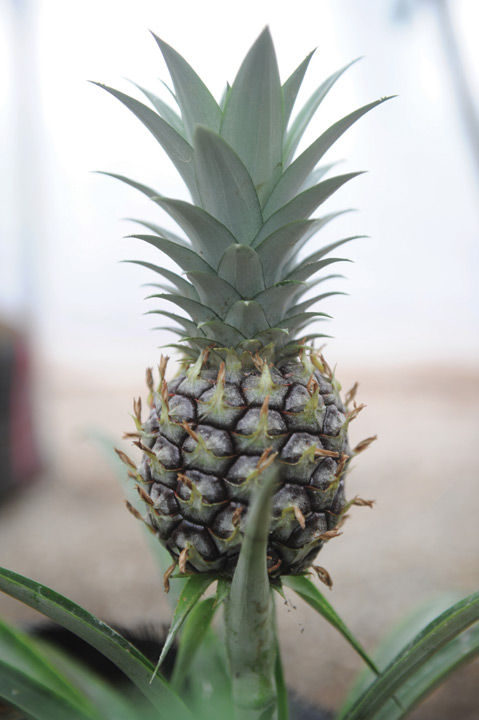
But Raquinio, a Big Island native, still wasn’t satisfied with the taste and yields of his organically grown delights, so he and his partner pulled the plug and went back to the greenhouse to fine-tune the formula. Currently, the duo is working with six different varieties from places like Brazil, Taiwan, Malaysia, and, of course, Hawai‘i as the two of them determine what exactly it takes to grow world-class papayas here in Santa Barbara County. It is, as Raquinio puts it, “experimental production.”
Eyeing a return to the farmers markets later this fall, the experimentalists’ work has already doubled their yield, and they’re now growing pineapples and bananas, as well. “We still have more questions than answers, but we are getting there,” said Raquinio. “Our goal is to eventually be the full-on tropical fruit guys. I mean, how cool will it be when we can go to market with full loads of locally grown organic papayas and pineapples and bananas for dollars on the pound less than Whole Foods?”
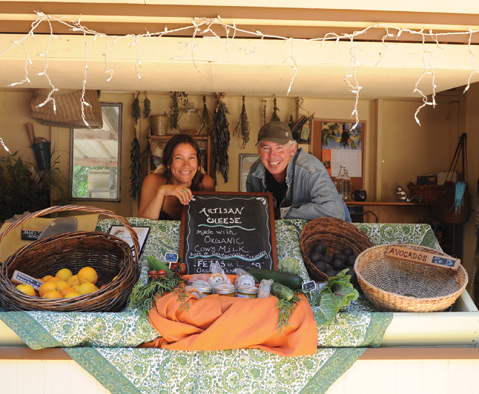
Casitas Valley Farm: Promoting Pigs, Cheese, and Permaculture
Who: Four generations of the Brush and Harvan families, including Warren Brush (founder of Regenerative Earth Farms) and his wife, Cyndi Harvan (and her parents and siblings); their daughter Anastasia and her husband, Jesse Smith (and their 8-month-old daughter, Phoenyx); and Cyndi’s cousin Makaila Harvan-Thompson (and her 5-month-old son, Kado).
What: Casitas Valley Creamery cheese; The Piggery sustainably raised pork (more than two dozen pigs, including three sows and one 700-pound boar named Ranger); 1,600 Hass avocados; 1.5 acres of apples; 3.5 acres of fuyu persimmons; and permaculture classes throughout the year.
Where: A 49.5-acre farm on Highway 150, just inside Ventura County.
When: Regenerative Earth Farms purchased the property in September 2012.
How: Casitas Valley Farm first hit the foodie scene back in the spring of 2013 for its creamery, the first artisanal cheese-making operation in the tri counties for as long as anyone could remember. But the much bigger dreams of globally renowned permaculture guru Warren Brush and his extended family — namely his son-in-law Jesse Smith, who oversees the farm’s day-to-day operations — are now growing deeper roots, as the hard work of turning conventionally farmed avocado, apple, and persimmon orchards into diverse, nutrient-rich food forests is fully underway.
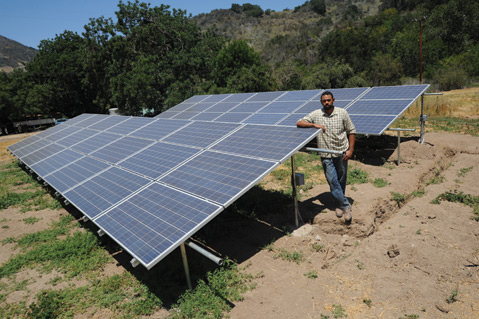
“The whole plan is to change this from a monoculture farm to a polyculture farm,” said Smith, while walking through his apple, persimmon, and avocado “deserts,” where he is now experimenting with interstitial plantings of lemon, lime, ginger, cardamom, kiwi, figs, mulberry, and even Jay Ruskey’s coffee. On the hillside, they’re stumping 60-foot-tall avocado trees to bring the canopy down but using the chopped wood on the slopes to make basins to collect water and nutrients, a job aided by the pumpkins sprouting there, as well. And in the apple orchard, which was decimated by moths last year, they’re using corrugated cardboard and wasps — not pesticides — to fight back.
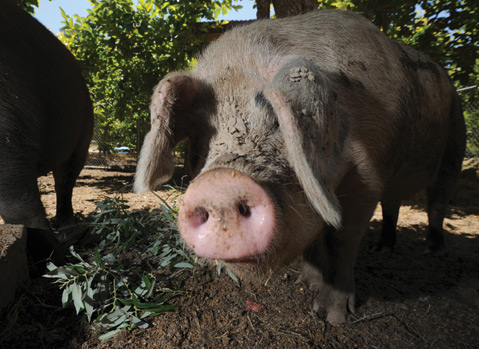
“We are making sacrifices up front for the benefit of the long-term system,” said Smith of the patience required for these systems to thrive, as opposed to just dumping nutrients into the soil to maximize crops and profits. “When you do these plantings, the way they are supposed to be done and create a food forest, everything works in unison.” Most of all, they want to share what they’re learning, offering permaculture classes, including a four-week intensive course that begins this week.
Then there are the pigs, nearly 30 of them at last count, huddled near the new solar panels and water well, all nourished from the leftover barley mash the farm gets from Island Brewing Company and Ventura Spirits. They’re now for sale to restaurants and private households as well as chopped into smaller cuts that are sold to members of The Piggery program, which people pick up monthly, much like the cheese program.
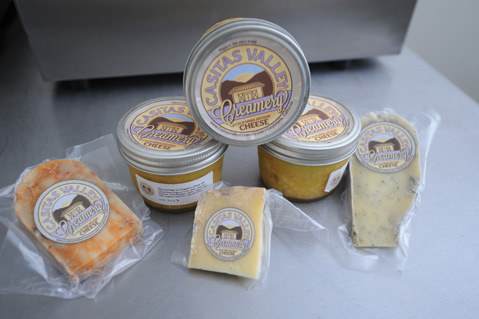
As for the creamery, which is managed by Brush’s niece Makaila Harvan-Thompson, it continues to thrive, as the crew received a “great response” during the California Artisan Cheese Festival in Petaluma. “We were really excited to be playing with the big boys,” said Smith. “Cheeseheads from all around loved our stuff.” They continue to search for a few milk animals of their own — and, perhaps harder to find, someone to milk them twice a day — but will then have to navigate the almost prohibitively strict federal dairy rules.
Perhaps then, Smith and company will be able to sit back at the end of the day, sip on some handmade persimmon brandy (now made from their trees by Ventura Spirits), and eat a homegrown fig wrapped in bacon that they cured and stuffed with cheese made from cows they raised.
Visit casitasvalley.com.
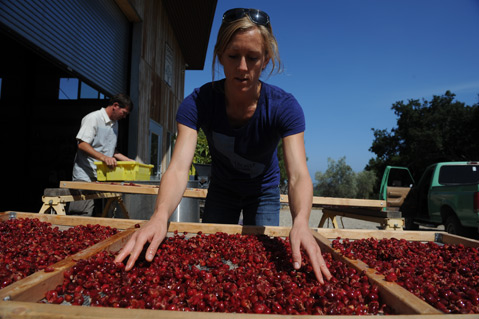
Good Land Organics: Conquering the Coffee Bean
Who: Jay and Kristen Ruskey, 7-year-old daughter Kasurina, and 4-year-old twins Aiden and Sean.
What: Coffee, finger/caviar limes, and dragon fruit, amid avocado and cherimoya orchards.
Where: Forty acres in the foothills off Farren Road on the cusp of western Goleta and the Gaviota Coast.
When: Jay’s parents bought the property in 1989.
How: No one ever thought coffee could grow in a Mediterranean climate — if so, why didn’t espresso-addicted Italians do it long ago? — and then Jay Ruskey came along and proved them all wrong. Today, thanks to his nearly decade-long experiment revealing that the coffee bean can be most tasty and profitable on the Santa Barbara coast, coffee aficionados around the world are waking up to a new frontier of possibilities.
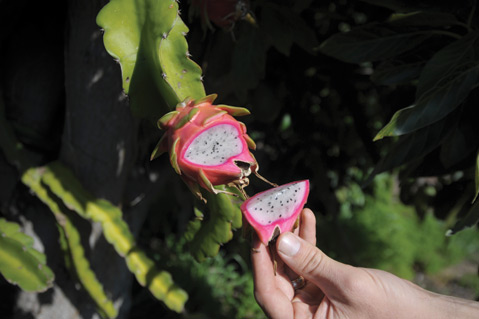
A quarter-century ago, the Hollywood-raised, Cal Poly–educated maverick started farming avocados on the property his parents bought in the foothills above Ellwood and dove headfirst into exotic crops as a member of the California Rare Fruit Growers’ Central Coast chapter. Cherimoyas were his first oddball fruit, and he tried everything else he could get his hands on: lychee and longan, goji berry and guava, dragon fruit and finger limes, those latter two most promising today.
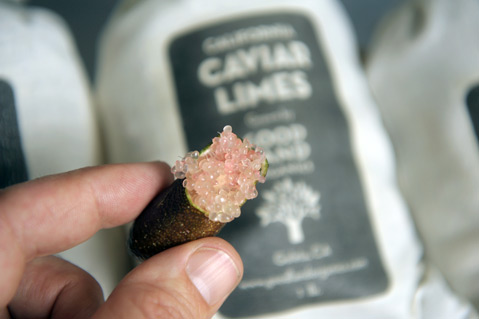
“We’ve learned a lot through failure,” said Ruskey, who eventually got his hands on coffee plants. “Out of just being efficient, I planted them under avocado trees on the same farming system. That was nine years ago.” He purchased processing equipment, and the coffee turned out quite good, especially from the high-elevation Central American varieties, as our latitude seems to compensate for their altitude.
“Simultaneously, the specialty market for coffee was really maturing beyond the Starbucks wave,” said Ruskey, whose University of California–aided experiments have always been market-driven. “It was no longer people drinking just regular coffee. They wanted to know how it was processed. They were willing to pay big money. It’s kind of where winegrowing was 25 years ago.” His coffee fetches more than $60 a pound for dried green beans on the international market, much of it going to Japan and England, though locals can snag a 5.5-ounce bag for $25 or take one of his monthly tours.
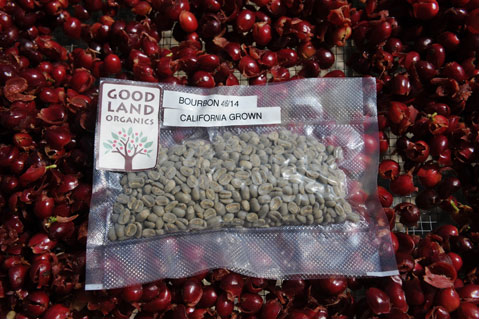
He recently founded Diversitree Nursery, a new nursery project for the coffee plants — which are now being experimented with by avocado growers in Morro Bay, Mission Canyon, and Carpinteria — as well as other specialty crops, such as black Périgord truffles, which he hopes to bring to Santa Ynez Valley vineyards. The overall goal is to promote “layered agricultural systems,” which maximize grower profits, bring new products to market, and are a more efficient use of the land.
When asked if he ever thought he’d be growing coffee in the hills of Goleta when he started farming, Ruskey laughed. “Agriculture is like sailing a boat,” he explained. “You just say, ‘I’m gonna do this course,’ and pick up where the current and winds and trends go and use your skills to optimize yourself in that direction. I think it’s a lot of fun. I really enjoy the coffee business.”
Visit goodlandorganics.com.



